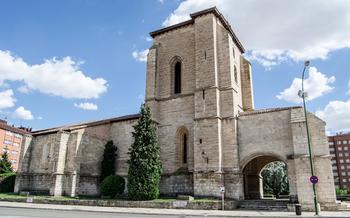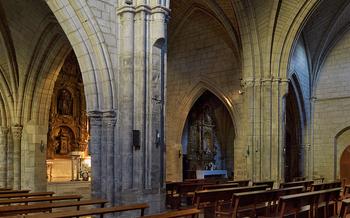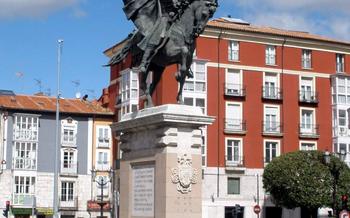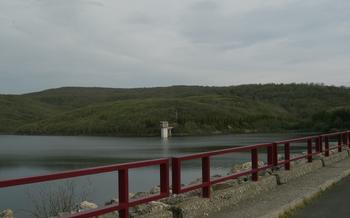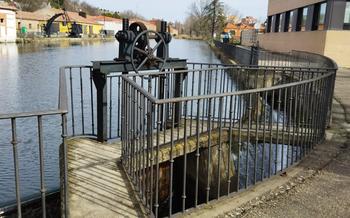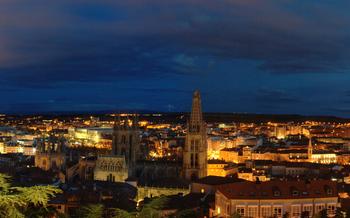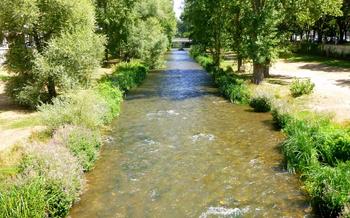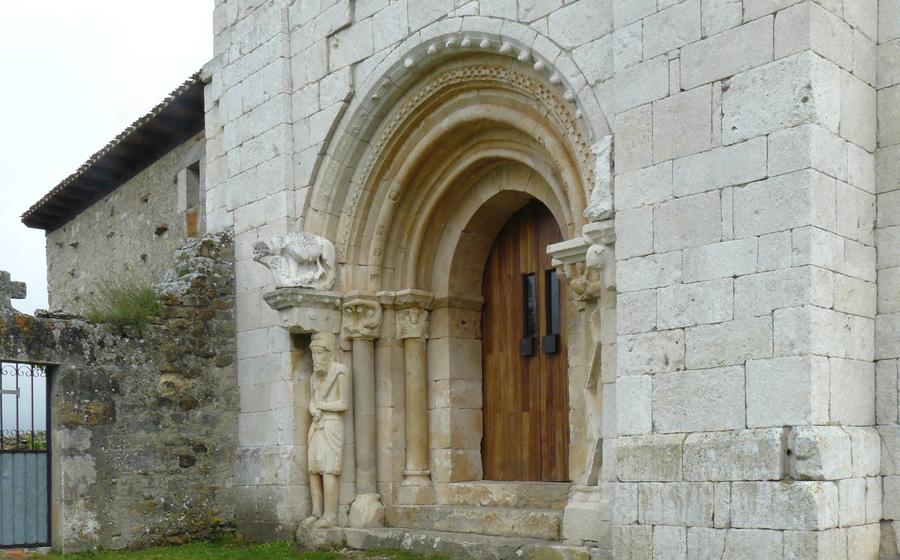
Ermita de San Pantaleón de Losa
- The Ermita de San Pantaleón de Losa
- Getting There and Parking
- Admiring the Exterior of the Ermita
- Taking in the Views
- Visiting the Nearby Villages
- Tasting the Local Cuisine
- Hiking and Biking Trails
- Horseback Riding
- Rock Climbing
- Fishing
- Cultural Events
- Insider Tip
The Ermita de San Pantaleón de Losa
The Ermita de San Pantaleón de Losa, located in the province of patron saint of physicians. The hermitage is located in a picturesque setting, surrounded by mountains, forests, and the Rudrón River. It is a popular destination for pilgrims and tourists alike.
Public transportation
The hermitage is accessible by public transportation. From Burgos, take the bus to Sotoscueva. From Sotoscueva, take a taxi or walk the remaining 2 kilometers to the hermitage.
Guided tours
Guided tours of the hermitage are available in Spanish and English. Tours typically last about 30 minutes and cover the history, architecture, and artwork of the hermitage.
Parking
There is limited parking available at the hermitage. It is recommended to park in the nearby village of Sotoscueva and walk or take a taxi to the hermitage.
Getting There and Parking
Public Transportation
The Ermita de San Pantaleón de Losa is accessible by public transportation. Buses run from Burgos to Sotoscueva, where you can transfer to a local bus that will take you to the ermita. The journey takes about 2 hours and 30 minutes.
Guided Tours
Guided tours of the ermita are available in Spanish and English. Tours typically last for about an hour and cover the history, architecture, and art of the building. Tours can be arranged in advance through the local tourist office or through a private tour operator.
Parking
There is limited parking available at the ermita. If you are driving, it is best to arrive early or park in the nearby village of Sotoscueva and walk to the ermita.
Admiring the Exterior of the Ermita
The Ermita de San Pantaleón de Losa boasts an impressive exterior that showcases the Romanesque style's grandeur. The Romanesque façade, with its intricate carvings and sculptures, is a true masterpiece. Admire the detailed depictions of biblical scenes and mythological creatures that adorn the doorway.
The apse, with its semi-circular shape and towering height, is another highlight of the exterior. The apse is decorated with a series of blind arches that add depth and texture to the structure. Take a moment to examine the unique carvings that adorn the apse's exterior, each telling a story from the Bible or local folklore.
The bell tower, with its slender silhouette and graceful arches, dominates the skyline of the ermita. Climb the tower's narrow staircase to enjoy breathtaking panoramic views of the surrounding countryside. From the top, you can admire the rolling hills, lush forests, and shimmering waters of the nearby reservoir.
The cloister, with its serene atmosphere and beautiful architecture, is a perfect place to escape the hustle and bustle of everyday life. Stroll along the cloister's arcaded walkways and admire the intricate carvings that decorate the columns and capitals. Take a moment to sit on one of the benches and soak in the tranquility of this sacred space.
Taking in the Views
The Ermita de San Pantaleón de Losa is situated in a stunning location, offering breathtaking views of the surrounding natural beauty. From the ermita, visitors can admire the majestic mountains that rise up all around, creating a awe-inspiring backdrop. The valley below is a lush green oasis, dotted with picturesque villages and farms. The nearby reservoir shimmers in the sunlight, adding to the idyllic scenery. Visitors can also spot several nearby villages nestled amidst the rolling hills, each with its unique charm and history. Taking in the views from the ermita is a truly unforgettable experience, allowing visitors to connect with the natural wonders of the region.
Visiting the Nearby Villages
Sotoscueva is a small village located just 2 kilometers from the Ermita de San Pantaleón de Losa. It is home to the Cueva de Sotoscueva, a large cave system with impressive stalactites and stalagmites. Visitors can take guided tours of the cave and learn about its history and geology.
Entrambasaguas is another nearby village, situated about 5 kilometers from the ermita. It is known for its beautiful Romanesque church, the Iglesia de Santa María la Mayor. The church dates back to the 12th century and features a number of well-preserved frescoes.
Lastras de Teza is a small village located about 10 kilometers from the ermita. It is home to the Museo de los Dinosaurios, a museum dedicated to the dinosaurs that once roamed the area. The museum features a number of exhibits on dinosaurs, as well as a collection of fossils.
Medina de Pomar is a larger town located about 20 kilometers from the ermita. It is a popular tourist destination due to its well-preserved medieval quarter. Visitors can explore the town's narrow streets, visit its historic buildings, and sample the local cuisine.
Tasting the Local Cuisine
The region of Burgos is renowned for its rich and varied cuisine. When visiting the Ermita de San Pantaleón de Losa, be sure to sample some of the traditional dishes and local specialties.
Traditional Dishes
Some of the most popular traditional dishes in the region include:
- Olla podrida: A hearty stew made with chickpeas, various meats, and vegetables.
- Cocido burgalés: A traditional Castilian stew made with chickpeas, pork, beef, and vegetables.
- Morcilla de Burgos: A type of blood sausage made with pork blood, rice, and spices.
- Queso de Burgos: A fresh, mild cheese made from sheep's milk.
Local Specialties
In addition to traditional dishes, the region of Burgos is also home to a number of local specialties, such as:
- Lechazo asado: A roast suckling lamb dish that is a specialty of the province.
- Judiones de La Granja: A type of large white bean that is grown in the region.
- Morcilla de Sotoscueva: A type of blood sausage made with pork blood, rice, and spices that is a specialty of the Sotoscueva Valley.
- Queso de Valdivielso: A type of cheese made from goat's milk that is a specialty of the Valdivielso Valley.
Recommended Restaurants
There are a number of excellent restaurants in the region where you can sample the local cuisine. Some of the most popular restaurants include:
- Mesón El Pinar: A traditional restaurant located in the village of Sotoscueva that serves a variety of traditional dishes and local specialties.
- Restaurante La Casona: A restaurant located in the village of Entrambasaguas that serves modern interpretations of traditional dishes.
- Restaurante El Mirador: A restaurant located in the village of Lastras de Teza that offers stunning views of the surrounding countryside and serves a variety of traditional dishes and local specialties.
- Restaurante El Molino: A restaurant located in the village of Medina de Pomar that serves a variety of traditional dishes and local specialties.
Food Festivals
The region of Burgos is home to a number of food festivals throughout the year. Some of the most popular food festivals include:
- The Festival of San Pantaleón: A food festival held in the village of San Pantaleón de Losa on July 27th that features a variety of traditional dishes and local specialties.
- The Medieval Market of Medina de Pomar: A medieval market held in the village of Medina de Pomar in August that features a variety of traditional dishes and local specialties.
- The Burgos International Folk Festival: A folk festival held in the city of Burgos in September that features a variety of traditional dishes and local specialties from around the world.
Hiking and Biking Trails
The area surrounding the Ermita de San Pantaleón de Losa is a paradise for hiking and biking enthusiasts. There are trails for all levels, from easy walks to challenging climbs, and the scenery is simply breathtaking.
One of the most popular trails is the Vía Verde del Ferrocarril de la Robla, a former railway line that has been converted into a scenic greenway. The trail is mostly flat and easy to navigate, making it ideal for families with young children. It also offers stunning views of the surrounding countryside.
For those looking for a more challenging hike, the GR-285 long-distance footpath is a great option. This trail takes you through the Montes Obarenes, a range of mountains that offer some of the most spectacular views in the region. The trail is well-marked and maintained, but it is important to be prepared for some steep climbs and rough terrain.
Mountain bikers will also find plenty of challenges in the area. The BTT Zona Norte de Burgos network of mountain bike trails offers a variety of routes for all levels, from easy dirt roads to technical singletrack. The trails are well-marked and maintained, and they offer a great way to explore the beautiful scenery of the Montes Obarenes.
Here are some tips for hiking and biking in the area:
- Be sure to wear comfortable shoes and clothing.
- Bring plenty of water and snacks.
- Be aware of the weather conditions and dress accordingly.
- Be respectful of the environment and wildlife.
- If you are hiking or biking alone, let someone know your plans.
Horseback Riding
The Montes Obarenes and the surrounding countryside offer a stunning backdrop for horseback riding. Whether you're a beginner or an experienced rider, there are guided horseback riding tours available to suit all levels of experience. These tours typically last for several hours and take you through forests, along mountain trails, and past picturesque villages.
Some of the most popular routes include the Ruta del Pantano del Ebro, which offers stunning views of the Ebro Reservoir, and the Ruta del Camino de Santiago, which follows part of the ancient pilgrimage route to Santiago de Compostela. Prices for guided horseback riding tours start at around €30 per person, and you can book your tour in advance through local riding schools or tour operators.
If you're an experienced rider and prefer to explore the area on your own, there are several companies that offer horse rentals. You can rent a horse for a few hours or for a full day, and prices typically start at around €20 per hour. Just be sure to bring your own helmet and riding gear, as these are not usually provided by the rental companies.
For a truly unique experience, consider taking a horseback riding tour at night. Several companies offer these tours, which allow you to explore the Montes Obarenes under the stars. Nighttime horseback riding tours typically cost around €40 per person, and they're a great way to see the area from a different perspective.
Rock Climbing
The Montes Obarenes, a mountain range located in the province of Burgos, offer a variety of climbing spots for climbers of all levels. The rocks in this area are limestone, which provides excellent friction and grip. There are both single-pitch and multi-pitch routes to choose from, and the scenery is stunning.
Some of the most popular climbing spots in the Montes Obarenes include:
- Peña del Castillo: This crag is located near the village of Losa del Obispo and offers a variety of single-pitch routes ranging from easy to difficult.
- Peña del Águila: This crag is located near the village of Trespaderne and offers a variety of multi-pitch routes ranging from moderate to difficult.
- Peña del Oso: This crag is located near the village of Merindad de Valdeporres and offers a variety of single-pitch and multi-pitch routes ranging from easy to difficult.
Guided climbing tours are available for those who want to learn the basics of rock climbing or who want to climb with a professional guide. Several companies offer guided climbing tours in the Montes Obarenes, including:
- Escuela de Escalada Burgos: This company offers guided climbing tours for all levels, from beginners to experienced climbers.
- Guías de Montaña Burgos: This company offers guided climbing tours for all levels, including multi-day climbing trips.
- Rocódromo Burgos: This indoor climbing gym also offers guided climbing tours in the Montes Obarenes.
Tips for rock climbing in the Montes Obarenes:
- Bring the right gear: Make sure to bring the appropriate climbing gear, including a helmet, harness, belay device, and rope.
- Be prepared for the weather: The weather in the Montes Obarenes can change quickly, so be sure to pack layers of clothing and a raincoat.
- Start with easy routes: If you are a beginner, start with easy routes and gradually work your way up to more difficult routes.
- Climb with a partner: Climbing with a partner is always safer, and it is also more fun.
- Have fun! Rock climbing is a great way to get exercise, enjoy the outdoors, and challenge yourself.
Fishing
The Ebro River, the Rudrón River, and the Trueba River all offer excellent fishing opportunities. Anglers can expect to catch a variety of fish, including trout, barbel, and carp.
Before you go fishing, it's important to purchase a fishing license. Licenses are available online or at local fishing shops. It's also important to be aware of the local fishing regulations. For example, there are restrictions on the size and number of fish that you can catch.
If you're new to fishing, there are a number of guided fishing tours available. These tours can teach you the basics of fishing and help you find the best spots to catch fish.
Here are some tips for fishing in the Burgos area:
- The best time to fish is in the spring and fall when the weather is mild and the fish are active.
- Use a variety of baits and lures to increase your chances of success.
- Be patient. It may take some time to catch a fish, especially if you're new to fishing.
- If you're fishing in a river, be aware of the current and the depth of the water.
- Be respectful of other anglers and share the fishing spots.
Cultural Events
Burgos and its surroundings offer a rich calendar of cultural events throughout the year. Some of the highlights include:
-
The Festival of San Pantaleón (July 27): This annual festival is held in the village of Losa and features religious processions, traditional music and dance performances, and a lively market.
-
The Medieval Market of Medina de Pomar (August): This popular market features hundreds of stalls selling medieval-themed goods, as well as live music, street theater, and other entertainment.
-
The Burgos International Folk Festival (July): This festival showcases traditional music and dance from around the world, with performances held in various venues throughout the city.
To make the most of your visit to the area, be sure to check the local calendar of events before you go. You can also find information on cultural events at the Burgos Tourism Office.
Tips for attending cultural events in the area:
-
Plan ahead: Some events, such as the Festival of San Pantaleón, attract large crowds, so it is important to book your accommodation and transportation in advance.
-
Dress appropriately: If you are attending a religious event, be sure to dress respectfully. For other events, such as the Medieval Market, you may want to dress in period costume.
-
Be prepared for crowds: Some events, such as the Burgos International Folk Festival, can be very crowded. Be prepared for long lines and delays.
-
Bring cash: Many vendors at cultural events only accept cash. Be sure to bring enough cash to cover your purchases.
Insider Tip
The best time to visit the Ermita de San Pantaleón de Losa is during the summer months, when the weather is warm and sunny. However, the ermita is also beautiful in the spring, when the wildflowers are in bloom, and in the fall, when the leaves of the surrounding trees turn golden brown.
If you're looking for a hidden gem in the area, be sure to visit the nearby village of Sotoscueva. This charming village is home to a number of medieval buildings, including the Church of Santa María la Mayor and the Casa Consistorial.
The people of Burgos are known for their warm hospitality and their love of good food. Be sure to try some of the local specialties, such as the morcilla de Burgos (blood sausage) and the queso fresco (fresh cheese).
If you're looking for a souvenir to take home, be sure to pick up a piece of pottery from the nearby village of Medina de Pomar. The potters of Medina de Pomar are renowned for their beautiful handmade ceramics.
